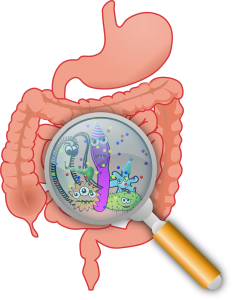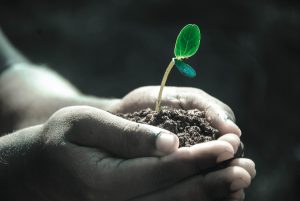 We are hearing more and more frequently about the importance of building healthy body terrain. Words like microbiome and virome are becoming commonplace. Building up the health of our resident community of microbes—weighing in at nearly 5 pounds in the largest of us—is a huge step toward maintaining a healthy body or healing an unhealthy one. The bacteria, viruses, fungi, and protozoa that make up a healthy microbiome optimizes body function by synthesizing vitamins, inhibiting pathogens, building neurotransmitters, increasing mitochondrial energy, and so much more. Since we share our bodies with such esteemed communities of microbes, then the million dollar question is how can we nurture our microbiome so that it can thrive?
We are hearing more and more frequently about the importance of building healthy body terrain. Words like microbiome and virome are becoming commonplace. Building up the health of our resident community of microbes—weighing in at nearly 5 pounds in the largest of us—is a huge step toward maintaining a healthy body or healing an unhealthy one. The bacteria, viruses, fungi, and protozoa that make up a healthy microbiome optimizes body function by synthesizing vitamins, inhibiting pathogens, building neurotransmitters, increasing mitochondrial energy, and so much more. Since we share our bodies with such esteemed communities of microbes, then the million dollar question is how can we nurture our microbiome so that it can thrive?
Tending Our Terrain
Our microbiome extends to many parts of our body, but is mostly in our gut. This is because our gut has by far the largest surface area in our body—roughly the size of an Olympic pool or a regulation tennis court—and is consequently our biggest exposure to our environment.
That’s a lot of terrain, a lot of soil. It takes a village—10,000 to 30,000 different species in a healthy gut—and a lot of vigilance to make sure that much soil is healthy, and we are the caretakers of that village. There are four ways that we can nurture, heal, and enrich this community of microbes.
- Reduce Toxicity
- Increase Inhalants
- Increase Contactants
- Increase Ingestants
Most of us have fallen far short of a healthy and diverse gut, walking around with a paltry 500 to 1000 species that are struggling in poisoned terrain. If we want to develop a healthy microbiome then we must do what we can to expand each of these four areas in our lives:
Reduce Toxicity
Reducing toxicity is more important than anything else we can do to nurture our microbiome. We can’t totally escape toxins. I mean, they are even in the rain. But we can minimize them:
Limit all drugs and antibiotics as much as possible. The seemingly innocent ones, like over-the-counter pain meds are some of the worst. There is not a quicker or better way than this to kill our microbes and decimate our microbiome.
Eliminate toxic personal and household products. There are healthier alternatives available in most stores.
Eat organic. We reduce our intake of herbicides, pesticides, fungicides, and GMOs by eating organic. The Dirty Dozen and the Clean 15 are great food lists for those on a budget. Growing our own food, whenever possible, is a great cost-effective way to nix toxicity.
Minimize emotion toxicity as much as possible. Fear, anxiety, guilt, anger, and shame are flagrant microbe killers.
Wild Outdoor Inhalants
Get outdoors and breathe good quality air in as many different rural and backcountry locations as possible:
 alpine meadows
alpine meadows- secluded beaches
- open deserts
- forest trails
- raging rivers
- wide-open prairies
- wild tundra expanses
- mountain streams
- rain forests
- marshlands
- swamps
- waterfalls
The air in each location has its own brand of microbial richness. The more diverse our macrobiome, the more diverse will be our microbiome. If one terrain-tending action (outside of reducing toxicity) has an edge over the others, then it’s this one.
“I really have a profoundly strong conviction that the more you can breathe in new environments, the longer you’re going to live.” Dr. Zach Bush
Weed the garden. Don’t have a garden? Then pull weeds wherever you see them. When we pull a plant out of the soil there is an invisible cloud of bacteria, fungi and microorganisms—we know the smell—that dramatically improves the terrain of our body ecosystem.
Garden and Pet Contactants
Weed the garden. Oh, did I mention that already? Well, it’s not just the inhaling. It’s getting dirt under our fingernails and all over our skin. Kids raised on farms are healthier—and so are we when we seek out and engage the earth wherever we find it but especially in rural environments. The positive effects of contact with dirt on the microbiome cannot be overstated. We can and should:
 Walk barefoot on dusty trails
Walk barefoot on dusty trails- Remove our shoes at the beach
- Soak in mountain hot springs
- Muddy up our mountain bike
- Wade in a stream
- Wriggle our toes in the grass or the mud
- Run in the rain
“Dirt is not just good for children. We all need a little dirt in our lives!” Christiane Northrup, M.D.
Pet the dog. Each animal hosts a substantially different combination of microbes. When we engage an animal they share their unique colony with us. Pet the cat. For that matter, pet the cow or the horse or the chicken…
Microbe-Nourishing Ingestants
Wild fermentation is a tasty and effective routine that will bring equilibrium to your body’s microbial community and transform your body’s function. A discussion on microbiome health and diversity wouldn’t be anywhere near complete without this wild world of microbe-nurturing foods.
- Make sauerkraut
- Brew kombucha
- Build sourdough bread or pancakes
- Lacto-ferment pickles
- Make your own yogurt or kefir
- Try sour reuben (for those who don’t like sauerkraut)
- Cook sourdough oats for breakfast
- The list goes on and on
Prebiotic foods: These are foods—like garlic, leeks, onions, apples, oats, and legumes— contain fibers and nutrients that feed the microbes. When we increase the diversity of our prebiotic foods, we increase the diversity and balance of our microbes. So go to an ethnic market once in a while and bring home new foods.
Healthy Terrain Is Not Optional
The microbiome mimics the macrobiome. The resulting condition of its soil community predicts the health of the organism. A healthy microbiome is a critical piece to the puzzle of why some catch that horrible bug and others don’t. As we are beginning to realize, community is everything. No man is an island. It takes a village to ensure our health, even if that village is mostly microbes. How can we expect to be healthy when most of our village has been devastated?
Consequently, we must engage in the wild, rich, and robust microbe-friendly habits above with frequency and abandon. Our very life depends on it.

Very informative and helpful! Thanks!